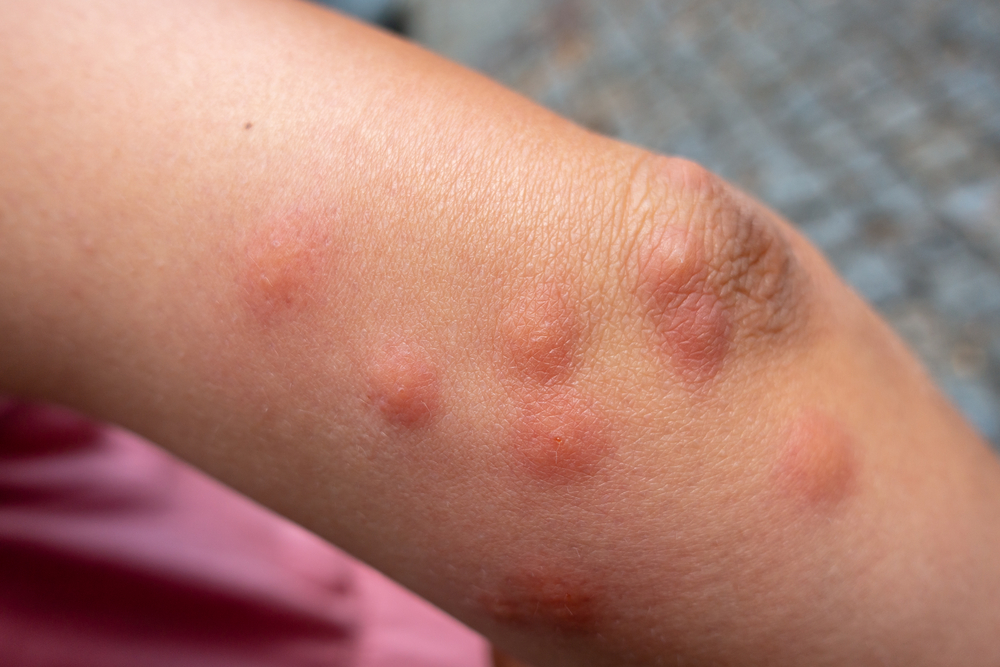*(CNN) — Something wasn’t right with Michelle Quinn. In mid-February of this year, she started noticing spots on the left side of her lower back. The 53-year-old resident of northwest Indiana thought maybe she was allergic to her detergent. Then the itchy places started spreading to other areas of her body — still all on her left side. That heightened the anxiety and the mystery. “It was itchy, but never in my life thought it was bedbugs.”
Then one night after work – about two weeks later – the thought of bedbugs did enter her mind. She was looking up pictures of them on Google when she noticed “a little tiny reddish bug” crawling across a piece of paper on her couch. She looked at the bug. Then the screen. Then the bug again.
“I was like ‘Nah, that can’t be.’ And so I kind of flicked it off and didn’t think anything of it until the next morning – when I wake up and I see one on my arm. And so I grabbed my phone and put it in camera and enlarged it and sure enough, that’s exactly what it was. And that of course is when the freaking out commenced.”
Bedbugs in the news
Quinn is hardly alone in grappling with these pests. Just ask the residents of (and visitors to) Paris, which reported in early fall 2023 a “widespread” rise in bedbugs, including sightings on public transit.
The French government has vowed action to “reassure and protect” the public in response.
Where and when these critters might strike is anyone’s guess.
“It’s hard to predict this sort of thing, but the scenario of record increases in travel and staff shortages in the hospitality industry is concerning in respect to bedbugs,” said Michael F. Potter, professor emeritus in the Department of Entomology at the University of Kentucky.
While bedbug infestations can happen in all types of places, hotels and other lodging are a major spreading spot, Potter said.
“The staff shortage issue is concerning because the best way for hotels to prevent infestations from escalating within their hotels is staying vigilant. And the biggest way they can do that is by performing regular inspections of their rooms … by the housekeepers who need to be trained and educated to spot infestations at their initial stages.”
The worse the staffing shortage, the harder it becomes to stay on top of the situation, Potter said.
Does it help if you flat-out ask about the bedbug situation at an establishment when you check in or make reservations?
“I think the reality is the person at the front desk is not going to be equipped to answer that question,” said Potter. “If I were in the hospitality industry, I’d be really schooling my people to respond to that question. But in terms of whether the guest is going to be able to get anything of any substance when they ask that question, I would say it’s exceedingly unlikely.”
Hotel room prevention tips
First thing to ask yourself: How much time and energy do you want to devote to bedbug prevention?
“Every traveler has to decide how vigilant they want to be in respect to bedbugs. Travel is stressful enough – or can be – and you’re trying to get away from all the things life throws at you,” said Potter. “So the last thing you want to be doing is … living out of your suitcase, living out of Ziploc bags, keeping your suitcase in the bathtub, which some people recommend but which I think is stupid.”
There are less drastic measures you can take.
Potter suggests that before you even unpack, at least do a cursory bed check. Pull back the sheets and blankets from the mattress and look around the seams of the mattress, particularly at the head area, for bedbugs themselves or signs of them (more on that below).
Check the seams of the mattress, too. This cursory check won’t reveal every place a bedbug could hide, Potter said, but it gives you the best shot of spotting an issue for the least effort.
A big thing to avoid: Don’t place your suitcase on the floor in the corner. That’s the best chance of bringing bedbugs home, Potter said. Put it instead on an elevated surface such as the top of a dresser or a luggage rack. If there are two beds in a room, Potter does not put his suitcase on the other bed.
The American Hotel & Lodging Association offers some additional tips:
• Check behind the headboard as best you can (that’s a tough one to check easily) and in sofas and chairs.
• If you see any signs of bedbugs, tell management right away. Ask for another room – ideally one not next to the problem room. If you aren’t satisfied, go to another place entirely if possible.
• If you have spotted bedbugs, consider putting a plastic trash bag or protective cover around your suitcase.
These are the signs of bedbug infestations
The US Environmental Protection Agency notes that other insects, such as carpet beetles, can be easily mistaken for bedbugs. So it’s good to educate yourself before your inspection. And that probably includes looking at gross, close-up pictures.
Usually, adult bed bugs are about the size of an apple seed (5 to 7 millimeters or 3/16 to 1/4 inch long). They’re long and brown, with a flat, oval-shaped body if they haven’t fed recently. They are balloon-like, reddish-brown and more elongated if they’ve fed.
Young bed bugs are usually smaller and are either translucent or whitish-yellow. If they haven’t recently fed, the nymphs can be nearly invisible to the naked eye. Bed bug eggs are the size of a pinhead and pearl-white.
You might not see the bugs themselves but rather their telltale signs, which might include:
• Rusty or reddish stains on sheets or mattresses (caused when they are crushed).
• Dark spots about the size of the bullet points in this list. Those spots are bedbug excrement after they’ve feasted on blood.
• Eggs and eggshells, which are quite tiny.
• The exoskeletons of the bugs, which they shed when they molt.
• A sweet, musty odor if the infestation is heavy.
Bedbugs are more than a bed and motel problem
While overnight lodging is a frequent culprit, the unfortunate truth is they can congregate and spread from multiple areas.
There’s the Paris issue in the early fall of 2023, and in another example, Daniel K. Inouye International Airport in Honolulu, Hawaii, had to close three gates in late May and deep clean the areas after bedbugs were found. Three more treatments were made, a Hawaii Department of Transportation spokesman told CNN Travel.
Potter said that schools, libraries, apartment buildings, movie theaters, hospitals, office buildings, taxis, buses, trains, dorms and student unions at colleges can all host bedbugs. He also noted it’s simply not practical to check all of that and cautions against getting paranoid over it.
But Potter has advice if you’ve encountered bedbugs at a hotel or Airbnb: “It’s bad enough if you get bit in a hotel, but what you really don’t want to do is bring these things home with you.”
He said take everything out of your suitcase and put it in garbage bags. Wash your clothes and then do an extended dry – the heat of a clothes dryer kills them.
As far as your suitcase goes, summertime heatwaves can be your friend. Just unzip the luggage, put it in your car, park it outdoors and the heat will kill bedbugs within an hour, Potter said. If it can’t get around 140 F (60 C) in your car, just throw away your suitcase if you’re concerned. That’s far less expensive than eradicating bedbugs from your home.
Medical and well-being issues
The US Centers for Disease Control and Prevention has one piece of good news if you’ve been feasted upon by bedbugs: They don’t spread any diseases (like the way mosquitoes transmit malaria or ticks transmit Lyme disease).
However, the itching from the bites can cause a loss of sleep and secondary skin infections if you scratch too often and hard. And some people might have a serious allergic reaction.
The Cleveland Clinic lays out the typical treatment plan:
• Wash the bites gently with soap and water.
• Use an anti-itch cream or lotion (look for hydrocortisone 1%) on your skin.
• Repeat once or twice a day until the itching fades.
If the itching is severe, the clinic says to talk to a healthcare provider about a stronger steroid cream or an over-the-counter or prescription antihistamine medication.
The effects on your mental well-being might be even rougher. People might feel anxious and even embarrassed, even though experts say it’s no reflection on personal hygiene or housekeeping.
“If you get bit by a mosquito outside, you whack it and you go indoors. If you’ve got a bedbug infestation in your home, it’s kind of unnerving,” Potter said. “It’s like ‘Am I going to get bit again tonight? Have I gotten rid of them all?’ So the emotional aspect, the loss of sleep, the anxiety … it’s a big thing. It can be very emotionally distressing to people who are fighting a bedbug problem in their home.”
What to do if you bring bedbugs home
Even if you just think you might have been exposed to bedbugs, you can take preemptive steps, such as running your travel clothes through the drier and wrapping items in plastic bags for week or longer.
If you bring some bedbugs from vacation to the sanctity of your home, the EPA has some additional advice. You need to prepare your home for treatment, including the following steps:
Reduce clutter: Get rid of old magazines and newspapers, keep your clothes off the floor and discard clothes you no longer use. Also, swap out cardboard boxes for plastic containers.
Turn your beds into islands: Move them at least 6 inches from the wall if possible. Try to rid your beds of all bedbugs, larvae and eggs. Snugly place bed-bug-proof covers (often called encasements) or liners on your mattress and box springs. The idea is to trap and starve the critters. Don’t let your bedding touch the floor.
Clean thoroughly: Heat is your friend. Put any clothing, bedding and other items that can withstand a HOT dryer 30 minutes), which will kill bed bugs and eggs. The EPA says “washing alone might not do the job [and] store clean items in a sealed plastic bag to ensure they remain bug free.” And “steam cleaners can get into cracks and fabrics to treat carpets, baseboards, bed frames, and other furniture. The steam temperature must be at least 130o F,” the EPA said.
The EPA warns against potentially unsafe treatments involving liquids such as rubbing alcohol, kerosene and gasoline that could easily ignite.
Depending on the level of infestation and your financial resources, you might need to turn to professionals to get the job done.
‘You become obsessed’
Michelle Quinn, who rents a place in northwest Indiana, can tell you all about the distress of being bitten.
First off, she’s never been able to figure out where they came from. That has vexed her. She took a trip to Washington, D.C., in January but didn’t notice being bit until mid-February. So she doesn’t think they came from her stay there.

“When this happens, you become obsessed,” Quinn said. “It was a nightmare.”
She had to take a series of costly measures to rid her place of the critters. That included turning to professionals for applications of a nicotine-based pesticide that she was told was safe for people and cats (she has two). She also had to toss out her couch and a vacuum among other things. She thinks it all cost her at least $1,200.
Her last treatment was in May, and she’s been bedbug-free since. Except maybe mentally.
Determined not to get bitten again, she’s put traps under her bed and couch legs, which she checks just about every day, and has “gone on a spackling spree” to cover every tiny crack in her plaster.
But her anxiety resurfaces anytime she feels itchy for any reason now. “You literally, pardon the pun, bug out.”
This article was first published in June 2023 and is updated periodically.
MORE NEWS ON EURWEB: Eaten by Bedbugs! Lashawn Thompson’s Death At Georgia Jail: Homicide Caused by Neglect | WATCH
The-CNN-Wire
™ & © 2023 Cable News Network, Inc., a Warner Bros. Discovery Company. All rights reserved.
We Publish News 24/7. Don’t Miss A Story. Click HERE to SUBSCRIBE to Our Newsletter Now!






